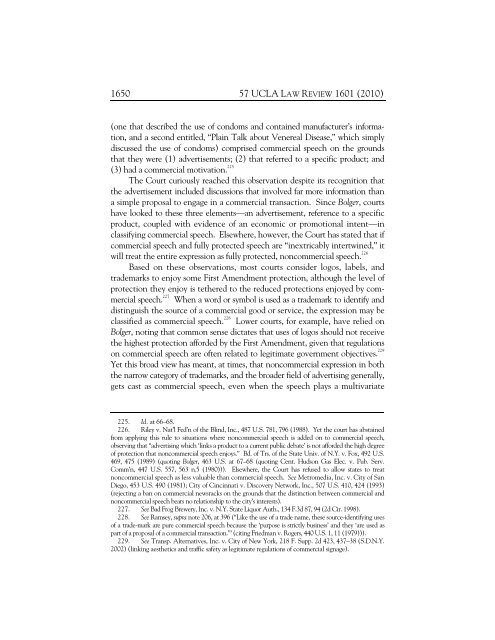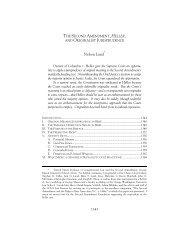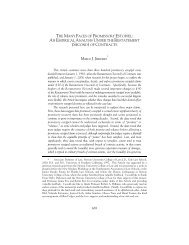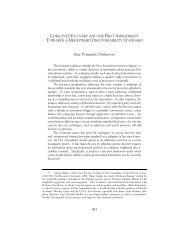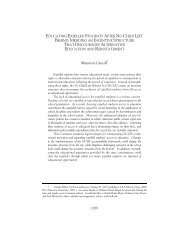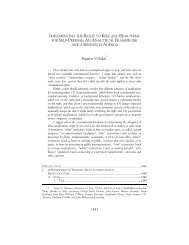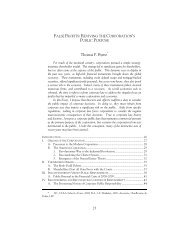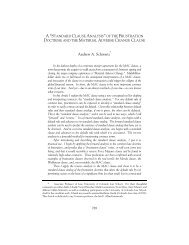Sonia K. Katyal - UCLA Law Review
Sonia K. Katyal - UCLA Law Review
Sonia K. Katyal - UCLA Law Review
You also want an ePaper? Increase the reach of your titles
YUMPU automatically turns print PDFs into web optimized ePapers that Google loves.
1650 57 <strong>UCLA</strong> LAW REVIEW 1601 (2010)<br />
(one that described the use of condoms and contained manufacturer’s information,<br />
and a second entitled, “Plain Talk about Venereal Disease,” which simply<br />
discussed the use of condoms) comprised commercial speech on the grounds<br />
that they were (1) advertisements; (2) that referred to a specific product; and<br />
(3) had a commercial motivation. 225<br />
The Court curiously reached this observation despite its recognition that<br />
the advertisement included discussions that involved far more information than<br />
a simple proposal to engage in a commercial transaction. Since Bolger, courts<br />
have looked to these three elements—an advertisement, reference to a specific<br />
product, coupled with evidence of an economic or promotional intent—in<br />
classifying commercial speech. Elsewhere, however, the Court has stated that if<br />
commercial speech and fully protected speech are “inextricably intertwined,” it<br />
will treat the entire expression as fully protected, noncommercial speech. 226<br />
Based on these observations, most courts consider logos, labels, and<br />
trademarks to enjoy some First Amendment protection, although the level of<br />
protection they enjoy is tethered to the reduced protections enjoyed by commercial<br />
speech. 227<br />
When a word or symbol is used as a trademark to identify and<br />
distinguish the source of a commercial good or service, the expression may be<br />
classified as commercial speech. 228<br />
Lower courts, for example, have relied on<br />
Bolger, noting that common sense dictates that uses of logos should not receive<br />
the highest protection afforded by the First Amendment, given that regulations<br />
on commercial speech are often related to legitimate government objectives. 229<br />
Yet this broad view has meant, at times, that noncommercial expression in both<br />
the narrow category of trademarks, and the broader field of advertising generally,<br />
gets cast as commercial speech, even when the speech plays a multivariate<br />
225. Id. at 66–68.<br />
226. Riley v. Nat’l Fed’n of the Blind, Inc., 487 U.S. 781, 796 (1988). Yet the court has abstained<br />
from applying this rule to situations where noncommercial speech is added on to commercial speech,<br />
observing that “advertising which ‘links a product to a current public debate’ is not afforded the high degree<br />
of protection that noncommercial speech enjoys.” Bd. of Trs. of the State Univ. of N.Y. v. Fox, 492 U.S.<br />
469, 475 (1989) (quoting Bolger, 463 U.S. at 67–68 (quoting Cent. Hudson Gas Elec. v. Pub. Serv.<br />
Comm’n, 447 U.S. 557, 563 n.5 (1980))). Elsewhere, the Court has refused to allow states to treat<br />
noncommercial speech as less valuable than commercial speech. See Metromedia, Inc. v. City of San<br />
Diego, 453 U.S. 490 (1981); City of Cincinnati v. Discovery Network, Inc., 507 U.S. 410, 424 (1993)<br />
(rejecting a ban on commercial newsracks on the grounds that the distinction between commercial and<br />
noncommercial speech bears no relationship to the city’s interests).<br />
227. See Bad Frog Brewery, Inc. v. N.Y. State Liquor Auth., 134 F.3d 87, 94 (2d Cir. 1998).<br />
228. See Ramsey, supra note 206, at 396 (“Like the use of a trade name, these source-identifying uses<br />
of a trade-mark are pure commercial speech because the ‘purpose is strictly business’ and they ‘are used as<br />
part of a proposal of a commercial transaction.’” (citing Friedman v. Rogers, 440 U.S. 1, 11 (1979))).<br />
229. See Transp. Alternatives, Inc. v. City of New York, 218 F. Supp. 2d 423, 437–38 (S.D.N.Y.<br />
2002) (linking aesthetics and traffic safety as legitimate regulations of commercial signage).


